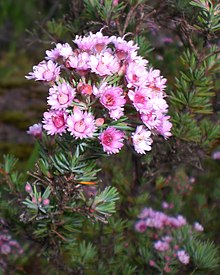- For the clam genus, see Verticordia (bivalve).
| Verticordia | |
|---|---|

| |
| V. plumosa growing on Mount Melville | |
| Scientific classification | |
| Kingdom: | Plantae |
| Clade: | Tracheophytes |
| Clade: | Angiosperms |
| Clade: | Eudicots |
| Clade: | Rosids |
| Order: | Myrtales |
| Family: | Myrtaceae |
| Tribe: | Chamelaucieae |
| Genus: | Verticordia DC. |
| Species | |
Verticordia is a genus of more than 100 species of plants commonly known as featherflowers, in the myrtle family, Myrtaceae. They range in form from very small shrubs such as V. verticordina to trees like V. cunninghamii, some spindly, others dense and bushy, but the majority are woody shrubs up to 2.0 m (7 ft) tall. The flowers are variously described as "feathery", "woolly" or "hairy" and are found in most colours except blue. They often appear to be in rounded groups or spikes but in fact are always single, each flower borne on a separate stalk in a leaf axil. Each flower has five sepals and five petals all of a similar size with the sepals often having feathery or hairy lobes. There are usually ten stamens alternating with variously shaped staminodes. The style is simple, usually not extending beyond the petals and often has hairs near the tip. All but two species are found in Southwest Australia, the other two occurring in the Northern Territory.
The first scientific collection of verticordia specimens was made in 1791 and the first formal description of a verticordia was written in 1826 but the name Verticordia was not used until 1828. Alex George undertook a revision of the genus and in 1991 published a paper describing three subgenera, 24 sections, and 102 species.
Verticordia species occupy a wide variety of habitats, with some species widespread and abundant whilst others are rare and endangered. The profuse and striking display of intricate flowers of many species has led them to being harvested for floristry or simply admired as a wildflower.